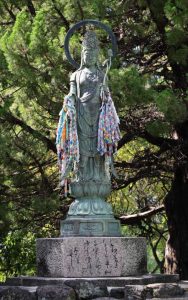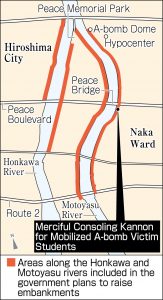Kannon statue erected by families to console A-bomb student victims from 21 Hiroshima schools will relocate to “place for safekeeping” ahead of government plan for river improvements
Jan. 10, 2024
by Kyosuke Mizukawa, Senior Staff Writer
An association for bereaved family members of the victims of Hiroshima First Middle School (present-day Kokutaiji High School, in Hiroshima’s Naka Ward) has decided to relocate the Merciful Consoling Kannon for Mobilized A-bomb Victim Students, a statue situated in Ote-machi in Hiroshima’s Naka Ward, to a different location in the city before the end of fiscal 2024. The association, which played a central role in erecting the Kannon statue, made the decision in the event of a relocation request from Japan’s national government, which plans to raise Motoyasu River embankments to prevent flooding from storm surges. The statue is currently located on the east bank of the river, an area that is part of the improvement plans. The association is soliciting contributions to cover expenses for the statue’s relocation with the aim of finding an appropriate “place for safekeeping.”
The two-meter Kannon statue is formed of bronze and stands south of the east end of Peace Bridge. It was erected in 1966 through the efforts of bereaved families of A-bomb victims from 21 prewar junior high schools and girls’ high schools, in response to a call for cooperation from parents of victims that had attended Hiroshima First Middle School. Inside the statue’s stone pedestal is a copper plate with the names of around 4,000 victims identified as of the time the statue was erected.
The statue is situated in an area where the river embankments are to be raised as part of the Ota River system improvement plan, formulated by the national government in fiscal 2011. According to the Ota River Office of Japan’s Ministry of Land, Infrastructure, Transport and Tourism, “The impact on individual monuments and other structures will not be known until after the construction plans have been determined. However, in the future, we might ask that the monuments be moved either temporarily or permanently.” The office added that no date has been set for the start of the improvement work.
On the other hand, the bereaved family association, which has looked after the statue since the beginning, entered into its own discussions about how to cope with the plan. The association ultimately decided on the move to a new location, given the difficulties its elderly members would face trying to find a new location after the government makes the request when the work is already set to begin. The group plans to move the main structure of the statue before the end of fiscal 2024, with a temple in the city considered a candidate site. What is to be done with the pedestal and the copper plate stored inside with the names of the victims will be considered after the main statue structure is moved.
The association is calling for contributions from people affiliated with Kokutaiji High School and the bereaved families of victims from other schools involved in originally erecting the statue. Shoyo Akita, 72, chair of the association who lives in Minami Ward, said, “The wishes of the bereaved family members for protection of the souls of the child victims and for peace are imbued in the Kannon statue. We hope to move the statue to an appropriate place for safekeeping.” For further information, contact the association at 082-264-1020.
Keywords
Ota River system improvement plan
In 2011, the Chugoku Regional Development Bureau of the Ministry of Land, Infrastructure, Transport and Tourism formulated the Ota River system improvement plan to raise embankments on the Ota, Honkawa, and Tenma rivers in the central part of Hiroshima in the event of storm surges. The improvement work, which started with the Tenma River, has yet to complete a stretch of about 2.8 kilometers on the Motoyasu River, about 1.4 kilometers on the Honkawa River, and 0.2 kilometers on the Tenma River. There are about 30 memorials, mostly around Peace Memorial Park, built on sites where mobilized students died in the atomic bombing. For the memorials, both disaster prevention and monument preservation have become issues of concern. A monument for the prewar Hiroshima Municipal Junior High School, formerly located on the already improved east bank of the Tenma River, was relocated to Motomachi High School, in Hiroshima’s Naka Ward, in 2017.
(Originally published on January 10, 2024)
An association for bereaved family members of the victims of Hiroshima First Middle School (present-day Kokutaiji High School, in Hiroshima’s Naka Ward) has decided to relocate the Merciful Consoling Kannon for Mobilized A-bomb Victim Students, a statue situated in Ote-machi in Hiroshima’s Naka Ward, to a different location in the city before the end of fiscal 2024. The association, which played a central role in erecting the Kannon statue, made the decision in the event of a relocation request from Japan’s national government, which plans to raise Motoyasu River embankments to prevent flooding from storm surges. The statue is currently located on the east bank of the river, an area that is part of the improvement plans. The association is soliciting contributions to cover expenses for the statue’s relocation with the aim of finding an appropriate “place for safekeeping.”
The two-meter Kannon statue is formed of bronze and stands south of the east end of Peace Bridge. It was erected in 1966 through the efforts of bereaved families of A-bomb victims from 21 prewar junior high schools and girls’ high schools, in response to a call for cooperation from parents of victims that had attended Hiroshima First Middle School. Inside the statue’s stone pedestal is a copper plate with the names of around 4,000 victims identified as of the time the statue was erected.
The statue is situated in an area where the river embankments are to be raised as part of the Ota River system improvement plan, formulated by the national government in fiscal 2011. According to the Ota River Office of Japan’s Ministry of Land, Infrastructure, Transport and Tourism, “The impact on individual monuments and other structures will not be known until after the construction plans have been determined. However, in the future, we might ask that the monuments be moved either temporarily or permanently.” The office added that no date has been set for the start of the improvement work.
On the other hand, the bereaved family association, which has looked after the statue since the beginning, entered into its own discussions about how to cope with the plan. The association ultimately decided on the move to a new location, given the difficulties its elderly members would face trying to find a new location after the government makes the request when the work is already set to begin. The group plans to move the main structure of the statue before the end of fiscal 2024, with a temple in the city considered a candidate site. What is to be done with the pedestal and the copper plate stored inside with the names of the victims will be considered after the main statue structure is moved.
The association is calling for contributions from people affiliated with Kokutaiji High School and the bereaved families of victims from other schools involved in originally erecting the statue. Shoyo Akita, 72, chair of the association who lives in Minami Ward, said, “The wishes of the bereaved family members for protection of the souls of the child victims and for peace are imbued in the Kannon statue. We hope to move the statue to an appropriate place for safekeeping.” For further information, contact the association at 082-264-1020.
Keywords
Ota River system improvement plan
In 2011, the Chugoku Regional Development Bureau of the Ministry of Land, Infrastructure, Transport and Tourism formulated the Ota River system improvement plan to raise embankments on the Ota, Honkawa, and Tenma rivers in the central part of Hiroshima in the event of storm surges. The improvement work, which started with the Tenma River, has yet to complete a stretch of about 2.8 kilometers on the Motoyasu River, about 1.4 kilometers on the Honkawa River, and 0.2 kilometers on the Tenma River. There are about 30 memorials, mostly around Peace Memorial Park, built on sites where mobilized students died in the atomic bombing. For the memorials, both disaster prevention and monument preservation have become issues of concern. A monument for the prewar Hiroshima Municipal Junior High School, formerly located on the already improved east bank of the Tenma River, was relocated to Motomachi High School, in Hiroshima’s Naka Ward, in 2017.
(Originally published on January 10, 2024)









